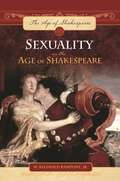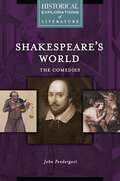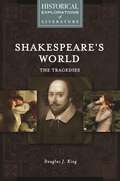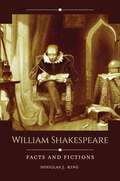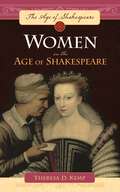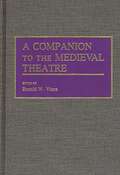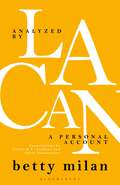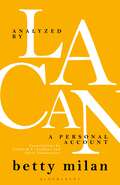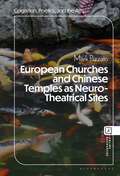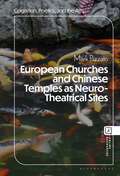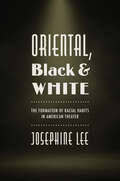- Table View
- List View
Sexuality in the Age of Shakespeare (The Age of Shakespeare)
by W. Reginald Jr.This book examines the important themes of sexuality, gender, love, and marriage in stage, literary, and film treatments of Shakespeare's plays.The theme of sexuality is often integral to Shakespeare's works and therefore merits a thorough exploration.Sexuality in the Age of Shakespeare begins with descriptions of sexuality in ancient Greece and Rome, medieval England, and early-modern Europe and England, then segues into examinations of the role of sexuality in Shakespeare's plays and poetry, and also in film and stage productions of his plays. The author employs various theoretical approaches to establish detailed interpretations of Shakespeare's plays and provides excerpts from several early-modern marriage manuals to illustrate the typical gender roles of the time. The book concludes with bibliographies that students of Shakespeare will find invaluable for further study.
Shakespeare's World: A Historical Exploration of Literature (Historical Explorations of Literature)
by John PendergastWith summaries, discussions, and excerpts from primary source documents, this book examines Shakespeare's world through careful consideration of the historical background of four of his comedies.Comedy was popular during the Renaissance, and it was also one of Shakespeare's specialties. The four plays discussed in this book, A Midsummer Night's Dream, The Merchant of Venice, Twelfth Night and The Tempest, span Shakespeare's career and remind us that Shakespeare, more than any of his contemporaries, explored the possibilities of comedy, consistently developing new approaches to the genre. Shakespeare was a fairly traditional playwright, well aware of the long tradition of comedy, which dates back to the Greeks and Romans. This book places Shakespeare's comedies in their historical context. It includes dedicated chapters on each of the four comedies, with each chapter providing a plot summary, a discussion of the play's historical background and significance, and excerpts from primary source documents related to the play. An introduction surveys the historical background of the plays, while a timeline chronicles key events that influenced them. Suggestions for further reading direct readers to additional sources of information.
Shakespeare's World: A Historical Exploration of Literature (Historical Explorations of Literature)
by Douglas J. KingThis analysis of primary documents allows readers to understand Shakespeare's tragedies within the context of historical issues of Renaissance England.Comprising dozens of primary source documents, this book explores Early Modern historical issues reflected in four of Shakespeare's tragedies most commonly taught in secondary schools and universities around the world: Romeo and Juliet, Julius Caesar, Hamlet, and Macbeth.Primary source documents relating to Romeo and Juliet deal with subjects such as dueling, breast-feeding, and the Black Plague. Background discussion of Julius Caesar addresses the influence of Roman culture on Renaissance England; the nature of monarchy; and warfare in Renaissance England, including the defeat of the Spanish Armada. The backdrop for Hamlet includes the nature of spirits; heaven, hell, and purgatory; the history of revenge tragedy beginning with ancient Greece; and debates over the theater in Shakespeare's time. Macbeth brings the reader into the reign of King James and examines ongoing debates over the dangers of witchcraft; the crime of the century, the Gunpowder Plot of 1605; and the "Macbeth curse" that has plagued productions of the Scottish Play since its premiere.
William Shakespeare: Facts and Fictions (Historical Facts and Fictions)
by Douglas J. KingBased on solid research and clear explanations, this book provides a thorough and up-to-date analysis of 10 key facts and fictions regarding the life and works of William Shakespeare.Shakespeare is perhaps the most famous author in world literature. His works have attracted tremendous critical and historical attention, and the world in which he lived has been the subject of hundreds if not thousands of books. But for all the attention given to Shakespeare and his world, arguments continue about what we can say for sure concerning his life and works. This book brings a unique perspective to the ongoing fascination and debate over the life and works of the most renowned writer of all time.The book focuses on 10 separate key issues, including Shakespeare's sexuality, his religion, his marriage and family, his education, and the vexing "authorship question." Each chapter treats a particular topic and provides a section on what people think happened, how the story developed, and what we now believe is the historical truth. This book looks objectively and closely at evidence to provide the most likely explanations for questions that cannot be definitively answered. Using historical primary source documents, it gives readers the clearest possible view of endlessly fascinating topics.
Women in the Age of Shakespeare (The Age of Shakespeare)
by Theresa D. KempThis book offers a look at the lives of Elizabethan era women in the context of the great female characters in the works of William Shakespeare.Like the other entries in this fascinating series, Women in the Age of Shakespeare shows the influence of the world William Shakespeare lived in on the worlds he created for the stage, this time by focusing on women in the Elizabethan and Jacobean eras in general and in Shakespeare's works in particular.Women in the Age of Shakespeare explores the ancient and medieval ideas that Shakespeare drew upon in creating his great comedic and tragic heroines. It then looks at how these ideas intersected with the lived experiences of women of Shakespeare's time, followed by a close look at the major female characters in Shakespeare's plays and poems. Later chapters consider how these characters have been enacted on stage and in film, interpreted by critics and scholars, and re-imagined by writers in our own time.
A Companion to the Medieval Theatre
by Ronald W. VinceVince has provided a useful and, for the most part, usable reference work. His introduction should be required reading for anyone approaching medieval theater. ChoiceScholars increasingly see medieval theatre as a complex and vital performance medium related more closely to political, religious, and social life than to literature as we know it. Reflecting the current interest in performance, A Companion to the Medieval Theatre presents 250 alphabetically arranged entries offering a panoramic view of European and British theatrical productions between the years 900 and 1550. The volume features 30 essays contributed by an international group of specialists and includes many shorter entries as well as systematic cross-referencing, a chronology, a bibliography, and a full complement of indexes.Major entries focus on the theatres of the principal linguistic areas (the British Isles, France, Germany, Iberia, Italy, Scandinavia, the Low Countries, and Eastern Europe), and on dramatic forms and genres such as liturgical drama, Passion and saint plays, morality plays, folk drama, and Humanist drama. Other articles examine costume, acting, pageantry, and music, and explore the theatrical dimension of courtly entertainment, the dance, and the tournament. Short entries supply information on over one hundred playwrights, directors, actors and antiquarians whose contributions to the theatre have been documented. This informative guide brings new depth to our appreciation of the richness and color of medieval public entertainments and the symbolism and pageantry that were a part of daily life in the Middle Ages. Designed to appeal to general reader, this volume is also an attractive choice for libraries serving students and scholars of theatre history, English and European literatures, medieval history, cultural history, drama, and performance.
Analyzed by Lacan: A Personal Account (Psychoanalytic Horizons)
by Dr. Betty MilanAnalyzed by Lacan brings together the first English translations of Why Lacan, Betty Milan's memoir of her analysis with Lacan in the 1970s, and her play, Goodbye Doctor, inspired by her experience. Why Lacan provides a unique and valuable perspective on how Lacan worked as psychoanalyst as well as his approach to psychoanalytic theory. Milan's testimony shows that Lacan's method of working was based on the idea that the traditional way of interpreting provoked resistance. Prior to Why Lacan, Milan wrote a play, Goodbye Doctor, based on her experience as Lacan's patient. The play is structured around the sessions of Seriema with the Doctor. Through the analysis, Seriema discovers why she cannot give birth, namely, an unconscious desire to satisfy the will of her father who didn't authorize her to conceive. She ceases to be the victim of her unconscious, grasps the possibility of choosing a father for her child and thus becoming a mother. Goodbye Doctor has been adapted into a film, Adieu Lacan, by the director Richard Ledes. Analyzed by Lacan features an Introduction by Milan to both works as well as a new interview with Mari Ruti about her writing and Lacan.
Analyzed by Lacan: A Personal Account (Psychoanalytic Horizons)
by Dr. Betty MilanAnalyzed by Lacan brings together the first English translations of Why Lacan, Betty Milan's memoir of her analysis with Lacan in the 1970s, and her play, Goodbye Doctor, inspired by her experience. Why Lacan provides a unique and valuable perspective on how Lacan worked as psychoanalyst as well as his approach to psychoanalytic theory. Milan's testimony shows that Lacan's method of working was based on the idea that the traditional way of interpreting provoked resistance. Prior to Why Lacan, Milan wrote a play, Goodbye Doctor, based on her experience as Lacan's patient. The play is structured around the sessions of Seriema with the Doctor. Through the analysis, Seriema discovers why she cannot give birth, namely, an unconscious desire to satisfy the will of her father who didn't authorize her to conceive. She ceases to be the victim of her unconscious, grasps the possibility of choosing a father for her child and thus becoming a mother. Goodbye Doctor has been adapted into a film, Adieu Lacan, by the director Richard Ledes. Analyzed by Lacan features an Introduction by Milan to both works as well as a new interview with Mari Ruti about her writing and Lacan.
European Churches and Chinese Temples as Neuro-Theatrical Sites (Cognition, Poetics, and the Arts)
by Prof. or Dr. Mark PizzatoCompares monumental designs and performance spaces of Christian, Buddhist, and related sanctuaries, exploring how brain networks, animal-human emotions, and cultural ideals are reflected historically and affected today as "inner theatre" elements. Integrating research across the humanities and sciences, this book explores how traditional designs of outer theatrical spaces left cultural imprints for the inner staging of Self and Other consciousness, which each of us performs daily based on how we think others view us. But believers also perform in a cosmic theatre. Ancestral spirits and gods (or God) watch and interact with them in awe-inspiring spaces, grooming affects toward in-group identification and sacrifice, or out-group rivalry and scapegoating. In a study of over 80 buildings – shown by 40 images in the book, plus thousands of photos and videos online – Pizzato demonstrates how they reflect meta-theatrical projections from prior generations. They also affect the embodied, embedded, enacted, and extended (4E) cognition of current visitors, who bring performance frameworks of belief, hope, and doubt to the sacred site. This involves neuro-social, inner/outer theatre networks with patriarchal, maternal, and trickster paradigms. European Churches and Chinese Temples as Neuro-Theatrical Sites investigates performative material cultures, creating dialogs between theatre, philosophy, history, and various (cognitive, affective, social, biological) sciences. It applies them to the architecture of religious buildings: from Catholic, Orthodox, and Protestant in Europe, plus key sites in Jerusalem and prior “pagan” temples, to Buddhist, Daoist, Confucian, and imperial in China. It thus reveals individualist/collectivist, focal/holistic, analytical/dialectical, and melodramatic/tragicomic trajectories, with cathartic poetics for the future.
European Churches and Chinese Temples as Neuro-Theatrical Sites (Cognition, Poetics, and the Arts)
by Prof. or Dr. Mark PizzatoCompares monumental designs and performance spaces of Christian, Buddhist, and related sanctuaries, exploring how brain networks, animal-human emotions, and cultural ideals are reflected historically and affected today as "inner theatre" elements. Integrating research across the humanities and sciences, this book explores how traditional designs of outer theatrical spaces left cultural imprints for the inner staging of Self and Other consciousness, which each of us performs daily based on how we think others view us. But believers also perform in a cosmic theatre. Ancestral spirits and gods (or God) watch and interact with them in awe-inspiring spaces, grooming affects toward in-group identification and sacrifice, or out-group rivalry and scapegoating. In a study of over 80 buildings – shown by 40 images in the book, plus thousands of photos and videos online – Pizzato demonstrates how they reflect meta-theatrical projections from prior generations. They also affect the embodied, embedded, enacted, and extended (4E) cognition of current visitors, who bring performance frameworks of belief, hope, and doubt to the sacred site. This involves neuro-social, inner/outer theatre networks with patriarchal, maternal, and trickster paradigms. European Churches and Chinese Temples as Neuro-Theatrical Sites investigates performative material cultures, creating dialogs between theatre, philosophy, history, and various (cognitive, affective, social, biological) sciences. It applies them to the architecture of religious buildings: from Catholic, Orthodox, and Protestant in Europe, plus key sites in Jerusalem and prior “pagan” temples, to Buddhist, Daoist, Confucian, and imperial in China. It thus reveals individualist/collectivist, focal/holistic, analytical/dialectical, and melodramatic/tragicomic trajectories, with cathartic poetics for the future.
Oriental, Black, and White: The Formation of Racial Habits in American Theater
by Josephine LeeIn this book, Josephine Lee looks at the intertwined racial representations of nineteenth- and early twentieth-century American theater. In minstrelsy, melodrama, vaudeville, and musicals, both white and African American performers enacted blackface characterizations alongside oriental stereotypes of opulence and deception, comic servitude, and exotic sexuality. Lee shows how blackface types were often associated with working-class masculinity and the development of a nativist white racial identity for European immigrants, while the oriental marked what was culturally coded as foreign, feminized, and ornamental. These conflicting racial connotations were often intermingled in actual stage performance, as stage productions contrasted nostalgic characterizations of plantation slavery with the figures of the despotic sultan, the seductive dancing girl, and the comic Chinese laundryman. African American performers also performed common oriental themes and characterizations, repurposing them for their own commentary on Black racial progress and aspiration. The juxtaposition of orientalism and black figuration became standard fare for American theatergoers at a historical moment in which the color line was rigidly policed. These interlocking cross-racial impersonations offer fascinating insights into habits of racial representation both inside and outside the theater.
